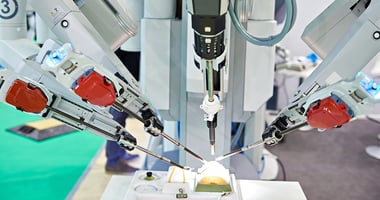What challenges are you facing that are slowing down the design and production phases of your...
Prosthetics Bring New Prospects for Engineers
Tomorrow’s engineers and today’s innovators are pursuing specialized education and career options that were never available, until now. The future is here. Technology that was once considered science fiction is reality—uniting engineering and medicine in cross-disciplinary collaborations is revolutionizing the field of prosthetics.
The human body is a biological machine with complicated mechanisms and systems for moving and the transporting fluids and electro-chemical signals. The age-old problem facing physicians is how to fix broken parts and systems to improve, sustain, and extend life. With advancements in technology, engineers have become integral to the design and application of prosthetics. From hands and feet for humans, to new limbs for pets, prosthetics are making great strides in medical engineering.
A recent article in IEEE InSight noted that expansion in the field of prosthetics over the past decade has transformed the industry into a viable career option for engineers wishing to specialize in medical applications. Prosthetics appeal to mechanical, electrical, and software engineers, alike, with modern, state-of-the art designs containing components such as actuators, microprocessors, and sensors.
A Brief History
Historically, these breakthroughs in prosthetic engineering have been slow to arrive. The first archeological evidence of a prosthetic device dates back to ancient Egypt, somewhere between 1,000 and 700 B.C. Known as the Cairo Toe, this prosthetic digit was composed of wood and leather and found strapped to the foot of a female mummy. A few spotty references to prosthetic iron hands exist in Roman battle history, but the Roman Empire’s best known contribution to prosthetic history was the Capua leg. The simple leg-shaped prosthesis was found in a grave in Capua, Italy and dates back to roughly 300 B.C.
Through the Dark Ages, prosthetics continued to evolve, albeit slowly. Historical evidence of iron hands, prosthetic hooks and arms, and peg legs showed minimal improvements in joint and socket designs at this time. The 1500s brought designs driven by necessity and were mainly fueled by those with the financial means to construct them. Some noted contributors include a German hand amputee, Götz von Berlichingen, who fashioned several prosthetic hands for himself using releases, springs, and leather straps. Later that same century, French Army surgeon Ambroise Paré introduced prosthetics with adjustable harnesses, joint lock controls, and hinges. Some of these basic engineering designs are still used today.
Through the early 1800s, prosthetic designs did incorporate some advancements in joint and sockets, but it wasn’t until the American Civil War, when battle injuries tragically increased the demand for prosthetics, that designs actually progressed. Once again, necessity proved the mother of invention. An engineer-turned-soldier, James Hanger, was faced with his own amputation and inspired to develop a prosthetic prototype, which he later patented as the “Hanger Limb.” Fashioned from the slats of wooden barrels, Hanger’s invention led to the founding of his own business catering to the needs of post war amputees.
Surprisingly, despite the mass production of prosthetic limbs following World War I and World War II, advancements in prosthetic limb design remained fairly stagnant. It wasn’t until post-war government investment into research financed the necessary groundwork in prosthetics, that technology began to catch up with the specialty.
Leaps and Bounds
More recently, IEEE InSights reported that ongoing military conflicts in Afghanistan and Iraq have brought an increase in prosthetic research funding from the Department of Veterans Affairs (VA) and the National Institutes of Health (NIH) and others, creating a resurgence in research and design.
Far from the original metal, wood and leather of the past, today’s prosthetics are made of plastic, aluminum, and composites—often utilizing 3D printing capabilities. Cutting edge designs incorporate microprocessors, computer chips, and robotics.
A recent review of the future of prosthetics in The Engineer detailed benefits of the new, state-of-the-art technology which, in some cases uses a phenomenon called myoelectricity. As the amputee uses muscles at the point of prosthetic attachment (socket), electrical signals on the skin are picked up by sensors in the socket. Though not the same as natural messaging and feedback from a biological limb, amputees can learn to adapt to the phenomenon to assist movement.
Myoelectricity is best used with hands and arms. Lower limb prosthetics are more complicated due to intricacies involving balance, gait and posture. Today’s advancements in lower limb prosthetics incorporate mechanical joints that use pneumatics controlled by electronic actuators, which help generate more realistic movements.
Another area of advancement involves interfacing human neural signals to control human limb movements. The American Society of Mechanical Engineers (ASME) outlined engineering advancements in 2018 to include brain-machine interfaces (BMI). With FDA approval of designs for use in clinical trials, the Defense Advanced Research Projects Agency (DARPA) is working to make BMI technology more accessible in home environments, as well as experimenting with using external devices to relay brain signals to limbs or other assistive devices.
Still looking to the future, ongoing progress is being made to incorporate sensory feedback into prosthetic limbs. This input includes pressure, temperature, and even visual images picked up with a webcam. The stimuli are interfaced with the prosthetic creating feedback, increased performance, and improved mobility for the amputee.
The use of these integrated technologies is further refining prosthetic performance and creating new challenges and opportunities for innovative professionals looking to bridge the gap between engineering and medicine.


